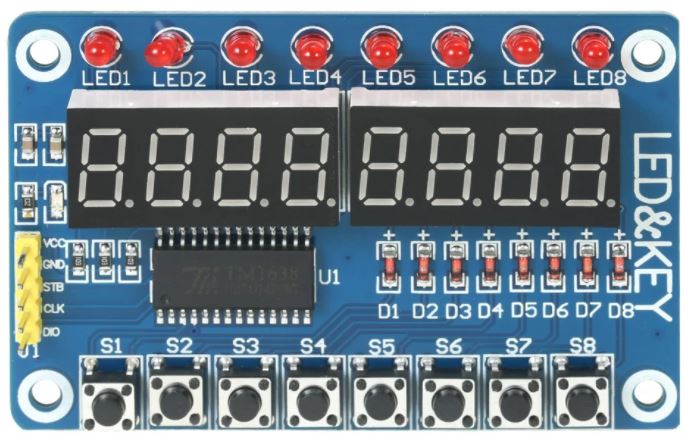TM1638 7 Segment Display Keypad & LED Module
The tm1638 display platform allows you to use the popular TM1638 7 Segment Display Keypad & LED Module with ESPHome.

The module can be powered with 5v DC. To display the colon punctuation use the
. in the colon place. (See clock example below)
# Example configuration entry
display:
platform: tm1638
id: tm1638_display
stb_pin: GPIOXX
clk_pin: GPIOXX
dio_pin: GPIOXX
intensity: 5
update_interval: 5s
lambda: |-
it.print("0123");Configuration variables
stb_pin (Required, Pin Schema): The pin you have the STB line hooked up to.
clk_pin (Required, Pin Schema): The pin you have the CLK line hooked up to.
dio_pin (Required, Pin Schema): The pin you have the DIO line hooked up to.
intensity (Optional, int): The intensity with which the TM1638 should drive the outputs. Range is from 0 (least intense) to 7 (the default). This setting will affect the 7 segment display and the 8 individual LED lights.
lambda (Optional, lambda): The lambda to use for rendering the content on the TM1638. See Rendering Lambda for more information.
update_interval (Optional, Time): The interval to re-draw the screen. Defaults to
1s.id (Optional, ID): Manually specify the ID used for code generation.
Rendering Lambda
The TM1638 has a similar API to the fully fledged Display Rendering Engine, but it’s only a subset as the TM1638
7-segment Display Keypad & LED Module does not have a concept of individual pixels. In the lambda you’re passed a variable called it
as with all other displays. In this case however, it is a TM1638 instance (see API Reference).
The most basic operation with the TM1638 is writing a simple number to the screen as in the configuration example
at the top of this page. But even though you’re passing in a string (here "0123" ), ESPHome converts it
into a representation that the TM1638 can understand: The exact pixels that should be turned on. And of course,
not all characters can be represented. You can see a full list of characters at the MAX7219 docs.
Each of the three methods (print, printf and strftime ) all optionally take a position argument at the
beginning which can be used to print the text at a specific position. This argument is 0 by default which
means the first character of the first TM1638. For example to start the first character of your text at
the end of the TM1638, you would write it.print(3, "0");.
Also note that the . (dot) character is special because when ESPHome encounters it in the string the dot
segment of the previous position will be enabled.
display:
- platform: tm1638
# ...
lambda: |-
// Print 0 at position 0 (left)
it.print("0");
// Result: "0 "
// Print 1 at position 1 (second character)
it.print(1, "1");
// Result: "01 "
// Let's write a sensor value (let's assume it's 42.1)
it.printf(0, "%.1f", id(my_sensor).state);
// Result: "42.1 " (the dot will appear on the "2" segment)
// Overwrite the previous content with blank
it.print(" ");
// Print a right-padded sensor value with 0 digits after the decimal
it.printf("S%3.0f", id(my_sensor).state);
// Result: "S 42"
// Print the current time
it.strftime("%H.%M");
// Result for 10:06:42 -> "10:06" on a display with : and "10.06" on a display with .Please see Formatted Text for a quick introduction into the printf formatting rules and
Displaying Time for an introduction into the strftime time formatting.
Creating a digital clock
The following example creates a typical digital clock with the : colon flashing every second.
time:
- platform: homeassistant
id: homeassistant_time
display:
platform: tm1638
clk_pin: GPIOXX
dio_pin: GPIOXX
stb_pin: GPIOXX
update_interval: 500ms
lambda: |-
static int i = 0;
i++;
if ((i % 2) == 0)
it.strftime("%H.%M", id(homeassistant_time).now());
else
it.strftime("%H%M", id(homeassistant_time).now());LEDs
The TM1638 7 Segment Display Keypad & LED Module has 8 LED lights across the top or middle of the display, depending on the board. These LEDs can be exposed as switches or outputs with the led property set between 0 and 7. The board has the LEDs labelled 1-8, but the leds use zero based addressing. The LED labelled “1” is LED 0 in the configuration.
switch:
- platform: tm1638
id: TM1638Led1
led: 0
output:
- platform: tm1638
id: TM1638Led2
led: 1Buttons
The TM1638 7 Segment Display Keypad & LED Module has 8 buttons across the top or middle of the display, depending on the board. These buttons are exposed as binary sensor components with the key property set between 0 and 7, They can be accessed via the binary sensor component configuration. As with the LEDs the buttons are labeled 1-8 on the board, but use zero based addressing. Therefore the button labelled “1” is key 0 in the configuration. See Binary Sensor Component
binary_sensor:
- platform: tm1638
name: "TM1638 Button 1"
id: TM1638Button1
key: 0
filters:
- delayed_on: 10ms
on_press:
then:
- switch.turn_on: TM1638Led1
on_release:
then:
- switch.turn_off: TM1638Led1
- platform: tm1638
name: "TM1638 Button 2"
id: TM1638Button2
key: 1
filters:
- delayed_on: 10ms
on_press:
then:
- output.turn_on: TM1638Led2
on_release:
then:
- output.turn_off: TM1638Led2
